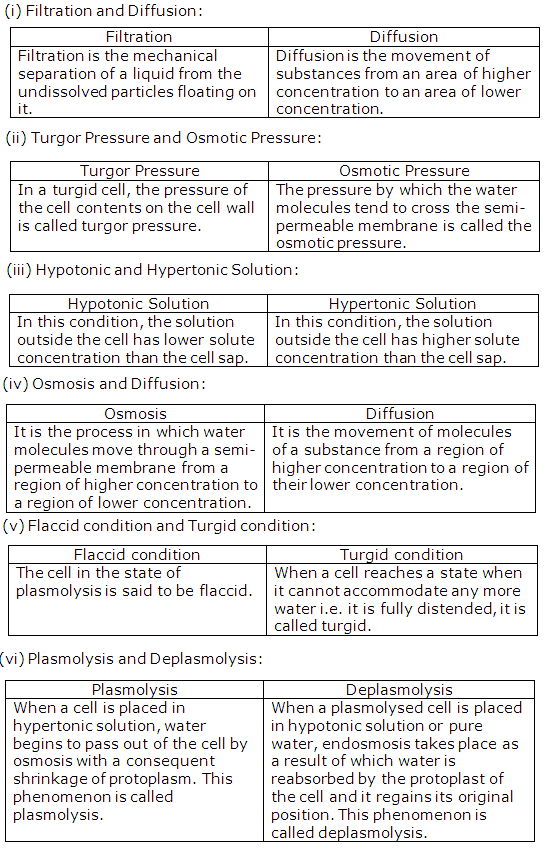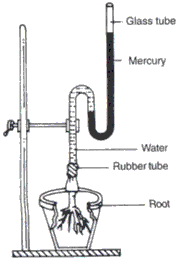Class 10 FRANK Solutions Biology Chapter 4 - Absorption by Roots
Study for your board exams using Frank Solutions for ICSE Class 10 Biology Chapter 4 Absorption by Roots available at TopperLearning. Learn the definition of terms such as diffusion, plasmolysis, osmosis, turgor pressure and more. Revise the differences between deplasmolysis and plasmolysis. Go through our Frank Solutions to understand how root hair is adapted for the absorption of water from the soil.
You can prepare for your Biology board exam by planning your chapter revision using the latest ICSE Class 10 Biology syllabus available on our study portal. Then, utilise our chapter resources like textbook solutions, practice tests and more for thorough revision of the chapter concepts and to excel in your final exam.
Absorption by Roots Exercise 48
Solution 8

Solution 4
Solution 5
Solution 9
Solution 6
Solution 10
Solution 7
(ii) They also help in the absorption of minerals.
Solution 11
(ii) Root hairs have a very large surface area.
Solution 1
(ii) Diffusion - It is the movement of molecules or ions from a region of higher concentration to a region of lower concentration to equalize the concentration of the two regions.
(iii) Turgor Pressure - It is the actual hydrostatic pressure developed inside a cell as a result of entry of water into it.
(iv) Hypertonic solution - A solution whose concentration is more than that of cell sap is called hypertonic solution.
(v) Plasmolysis - The shrinkage of cytoplasm of a living cell as a result of exosmosis is known as plasmolysis.
Solution 2

Solution 12

(ii) (a) Cell wall separates the two solutions - cell sap and soil solution and is permeable which means it allows the water to enter inside the root hair cells by endosmosis.
(b) The cytoplasm contains vacuoles having cell sap or solution of mineral salts. This cell sap being more concentrated than the soil solution help in water absorption by endosmosis.
(iii) If the soil was watered with extremely concentrated solution of sodium chloride, the water will move out from the root hair due to osmosis and thus, plasmolysis will take place.
Solution 3

Absorption by Roots Exercise 49
Solution 20
Solution 21
(ii) Plasma membrane
(iii) Large vacoule
(iv) The chloroplasts would be present in the shrunken protoplast.
(vi) Cell wall
Solution 13
(ii) Root hair
(iii) Sugar solution
(iv) The level of the liquid in the capillary tube rises.
Solution 14
(ii) Isotonic solutions
(iii) Cohesive force
(iv) Active absorption
(v) Xylem
(vi) Plasmolysis
(vii) Endosmosis
(viii) Endosmosis
(ix) Diffusion
Solution 16
Solution 17
Solution 18
Solution 19
Exercise
Solution
Absorption by Roots Exercise 50
Solution 25
Demonstration of Root pressure:

(a) Take a well matured healthy herbaceous plant.
(b) The stem of the plant is cut a few centimeters above the base with a sharp knife and attached to a manometer through a rubber tube.
(c) After a few hours, the level of mercury rises in the manometer.
(d) This is due to the pressure created by water exuded from the cut end of the plant on account of root pressure generated due to entry of water in the root cells.
Solution 26
(ii) Water is important for seed germination.
(iii) Water controls the opening and closing of stomata.
Solution 27
Solution 28
(ii) Roots supply water to the stem and leaves of the plant.
(iii) In root hairs, the xylem is not fully mature and the endodermis and epidermis are permeable to water.
(iv) Water is absorbed by the plants through xylem in all directions.
(v) The food on the other hand is transported with the help of phloem.
Solution 29
(ii) In shoot, (a) phloem has been removed. In shoot (b), xylem has been removed.
(iii) In shoot (b), xylem has been removed so the leaves are wilted. But in shoot (a), xylem has not been removed so the leaves are turgid.
Solution 30
(ii) In (b), the water would move up slowly.
(iii) To prevent evaporation of water.
(iv) Absorption of water by the roots.
Solution 22
(ii) Saline water is hypertonic. So any infectious agent such as bacteria in the throat gets plasmolysed and this cures the infection.
(iii) Jam, jellies and pickles are kept in hypertonic solution of sugar or salt in which plasmolysis of bacteria and fungi takes place. This kills the bacteria and fungi and hence, pickles, jam and jellies are preserved properly.
(iv) The leaves of the wilted lettuce become crisp when kept in cold water because they take up water due to endosmosis in hypotonic solution.
Solution 23
Solution 24
Absorption by Roots Exercise 51
Solution 31
(ii) (d) plasmalemma
(iii) (c) hypertonic solution
(iv) (b) plasmolysis
(v) (a) endosmosis
(vi) (b) endosmosis
(vii) (a) Plasmalemma
(viii) (b) imbibition
(ix) (c) reaching of water upwards against gravitational force
(x) (b) by xylem
(xi) (d) Xylem
(xii) (b) root hairs
(xiii) (d) none of the above
(xiv) (a) xylem
(xv) (c) hydrostatic pressure in the root
(xvi) (b) xylem is blocked

